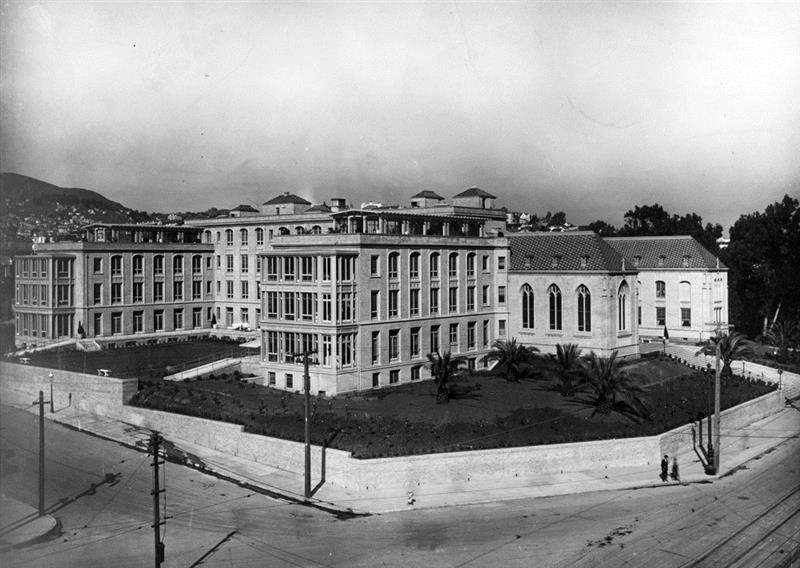
RETURN TO HOME PAGE
FEEDBACK
 |
May 2013 RETURN TO HOME PAGE FEEDBACK |
By Heather World

Much of the original St. Luke’s Hospital was destroyed in the 1906 earthquake. It was rebuilt in 1912, but the only portion of the old hospital that remains is the building on the right, which looks out onto Valencia Street. The larger building to the left, which is along Duncan Street, has been replaced by the Monteagle Medical Office Building. If a new plan for the complex goes forward, the existing hospital will be torn down and a new seven-story hospital and five-story medical office building will be erected on the site. Photo courtesy of California Pacific Medical Center
The proposed St. Luke’s Hospital grew by two stories and 40 beds in the latest compromise between city officials and California Pacific Medical Center, which has been negotiating for more than six years to upgrade and expand its city facilities.
The agreement calls for a seven-story, 120-bed acute care hospital on the site of what is presently a physician’s parking lot along Cesar Chavez Street to the west of the current hospital. The new emergency room would be 50 percent larger than the present one, said Mark Farrar, a CPMC representative who spoke to the couple of dozen neighbors gathered at an April 10 meeting of Upper Noe Neighbors.
Drawings made prior to the re-sized hospital show a tree-lined, terraced pedestrian plaza leading from Cesar Chavez to the entrance of the campus on 27th Street. A three-dimensional model is on display in the existing hospital’s lobby.
A spokesman said CPMC hoped the estimated $500 million project would start construction in 2015 and end in 2019. Once patients were transferred to the new hospital, the existing hospital would be torn down and replaced by a five-story medical office building.
Initially, CPMC planned for an 80-bed five-story hospital, and city leaders had asked the nonprofit to guarantee St. Luke’s would remain open for 20 years and continue to serve its mostly low-income population.
The new deal—a bigger hospital that will presumably attract more physicians and patients—is better, said District 9 Supervisor David Campos, who was instrumental in cementing the pact.
“Sutter [Health] can’t be successful unless St. Luke’s is successful,” he said. “I think we get a viable, world-class hospital for the southeastern part of San Francisco that will serve those neighborhoods for years to come.”
All the services now offered at St. Luke’s, like a breast healthcare center and diabetes management, will still be offered. In addition, the complex is required to create “Centers of Excellence” in senior and community health.
“We want to attract patients from the neighborhood,” said Farrar.
The medical office building is so key to the deal that if CPMC doesn’t submit plans for the building within five years of the new hospital’s opening, it would be required to give the land to the city for free. The city would then work with a developer to build a medical office building on its own, Campos said.
The entire deal must still be approved in steps by the Planning Commission, and Campos said he expected to see it then come before the Board of Supervisors in June.
Neighbors at the meeting expressed concerns over traffic, excitement about nearby quality medical care, and confusion about the details of the project.
“It’s all up in the air,” said Marianna Ferris, who lives next to St. Luke’s on Cesar Chavez. “The big issue is that we don’t know right now.”
Campos promised more outreach to neighbors in the months ahead.